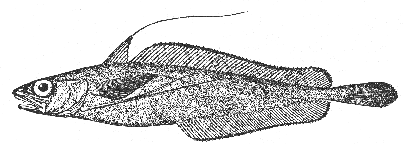Long-finned hake Urophycis chesteri (Goode and Bean) 1878
[Jordan and Evermann, 1896-1900, p. 2556.]
Description—
The most distinctive character of the long-finned hake is its very long ventral fins, the longest of the rays of which reach back nearly to the rear end of the anal fin (about to its fortieth ray), with the next longest ventral ray considerably overlapping the origin of the anal. The filamentous dorsal ray is longer also, than in the other Gulf of Maine hakes, reaching back to about the middle of the second dorsal fin or beyond. Furthermore, there are only about 90 rows of scales from gill opening to caudal fin along the lateral line, and the scales are relatively larger than in either the white hake or the squirrel hake; the eye is larger in the long-finned hake; the anal fin rays are more numerous (average about 56), the rear corners of the dorsal and anal fins are more rounded. The outline of the anal is slightly concave instead of straight (fig. 111); the pectoral fins are more slender and more pointed, and the caudal fin is narrower with more strongly convex margin; these differences are more clearly shown in the illustrations than verbally. The skin of the long-finned hake is curiously loose, like that of many deep-sea fishes.
Color—
Freshly preserved specimens are olive above and on the sides, with a silvery white belly. The fins are olive, with dusky markings on the dorsal filament, on the outer edge of the dorsal fins, on the caudal fin, and on the ventrals.
Size—
Specimens 14 to 15 inches (36 to 38 cm.) long, trawled by Albatross III, on the southwestern slope of Georges Bank and off Nantucket Shoals, in 105 to 240 fathoms, May 11-18, 1950, are the largest yet recorded.
Habits—
The long-finned hake is a bottom fish, living chiefly between 100 and 500 fathoms, the deepest record for it is from 538 fathoms. It is a summer and autumn spawner, judging from the fact that Goode and Bean saw specimens in breeding condition at that season. We have taken pelagic young of 8 to 35 mm. in our tows off Marthas Vineyard during the last week of August.[55] And captures of 3 fry, about 2¼ to 2¾ inches (57-71 mm.) long on April 26 (1931) and of 16 fish of about 3 to 4¼ inches (74-110 mm.) late that July suggests that a length of 4 to 5 inches is reached at 1 year of age.
General range—
This is a deep-water fish, occurring in great abundance on the continental slope off North America from the Laurentian Channel in Cabot Strait to abreast of Cape Lookout, N. C.
Occurrence in the Gulf of Maine—
This hake is plentiful all along the seaward slopes of Browns Bank, of Georges Bank and of Nantucket Shoals at depths greater than 100 fathoms, where it has been trawled at many stations.[56]
The Albatross III, for example, caught 861 in 63 half-hour trawl hauls, at 105 to 240 fathoms on the slope between the south-central part of Georges Bank (long. 67° 14' W.) and the offing of the eastern end of Long Island, New York (long. 71° 57' W.) in May 1950. Up to 1931 the only [page 233] definite records of them from the inner parts of the Gulf had been of three specimens taken off Cape Ann,[57] in 110 to 140 fathoms, in 1878; and of a few others that were trawled on the northern edge of Georges Bank by the Kingfisher, in September 1929, in 85 to 100 fathoms. But captures of a number to the westward along the Bank and in the central basin of the Gulf in the summer of 1931, by the Albatross II[58] at depths of 70 to 140 fathoms, show that long-finned hakes are more numerous in the deeper parts of the Gulf than had been suspected previously.
[55] Bigelow, Bull. Mus. Comp. Zool., vol. 59, No. 8, 1917, p. 275.
[56] For early locality records see Goode and Bean, Smithsonian Contrib. Knowl., vol. 30, p. 361.
[57] These were the basis of Goode and Bean's original description of the species (Proc. U. S. Nat. Mus., vol. 1, 1878, p. 256).
[58] Reported by Bigelow and Schroeder, Bull. U. S. Bur. Fish., vol. 48, 1936, p. 339.
